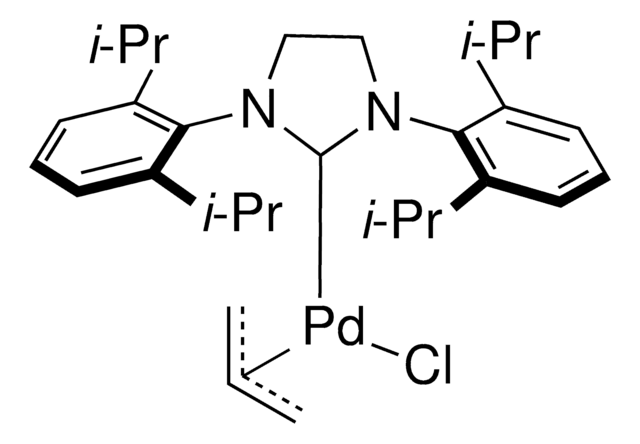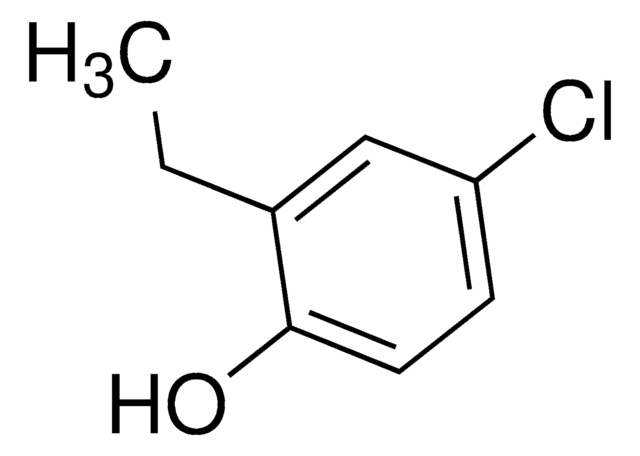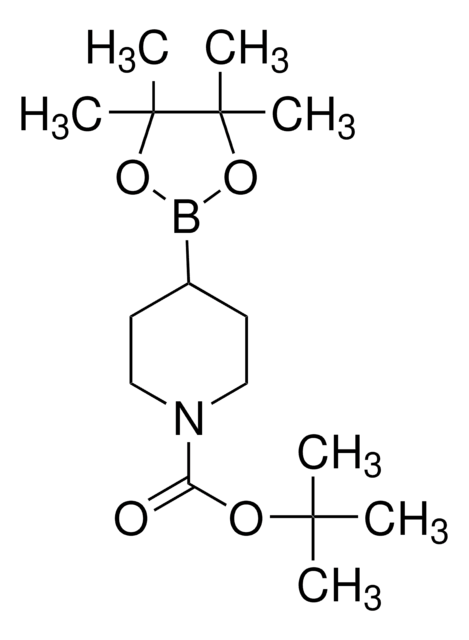Alle Fotos(1)
Wichtige Dokumente
279552
4-Chlor-3-ethylphenol
97%
Anmeldenzur Ansicht organisationsspezifischer und vertraglich vereinbarter Preise
Alle Fotos(1)
About This Item
Lineare Formel:
ClC6H3(C2H5)OH
CAS-Nummer:
Molekulargewicht:
156.61
EG-Nummer:
MDL-Nummer:
UNSPSC-Code:
12352100
PubChem Substanz-ID:
NACRES:
NA.22
Empfohlene Produkte
Assay
97%
Form
solid
mp (Schmelzpunkt)
45-50 °C (lit.)
Funktionelle Gruppe
chloro
SMILES String
CCc1cc(O)ccc1Cl
InChI
1S/C8H9ClO/c1-2-6-5-7(10)3-4-8(6)9/h3-5,10H,2H2,1H3
InChIKey
DVKVZPIRWWREJC-UHFFFAOYSA-N
Anwendung
4-Chloro-3-ethylphenol is a ryanodine receptor antagonist and is commonly used as research tool and diagnostic reagent for malignant hyperthermia.
Signalwort
Warning
H-Sätze
Gefahreneinstufungen
Eye Irrit. 2 - Skin Irrit. 2 - STOT SE 3
Zielorgane
Respiratory system
Lagerklassenschlüssel
11 - Combustible Solids
WGK
WGK 3
Flammpunkt (°F)
235.4 °F - closed cup
Flammpunkt (°C)
113 °C - closed cup
Persönliche Schutzausrüstung
dust mask type N95 (US), Eyeshields, Gloves
Hier finden Sie alle aktuellen Versionen:
Besitzen Sie dieses Produkt bereits?
In der Dokumentenbibliothek finden Sie die Dokumentation zu den Produkten, die Sie kürzlich erworben haben.
M U Gerbershagen et al.
European journal of anaesthesiology, 19(2), 135-140 (2002-05-10)
The in vitro contracture test with halothane and caffeine is the current gold standard for diagnosis of malignant hyperthermia. This test has a sensitivity of 99.0% but a specificity of only 93.6%. Therefore, an alternative drug is desirable which distinguishes
A M Low et al.
British journal of pharmacology, 122(3), 504-510 (1997-11-14)
1. Recently, 4-chloro-3-ethyl phenol (CEP) has been shown to cause the release of internally stored Ca2+ apparently through ryanodine-sensitive Ca2+ channels, in fractionated skeletal muscle terminal cisternae and in a variety of non-excitable cell types. Its action on smooth muscle
Bo Zeng et al.
British journal of pharmacology, 171(5), 1250-1259 (2014-03-29)
Depletion of the Ca(2+) store by ryanodine receptor (RyR) agonists induces store-operated Ca(2+) entry (SOCE). 4-Chloro-3-ethylphenol (4-CEP) and 4-chloro-m-cresol (4-CmC) are RyR agonists commonly used as research tools and diagnostic reagents for malignant hyperthermia. Here, we investigated the effects of
Francisco H Andrade et al.
Investigative ophthalmology & visual science, 46(12), 4541-4547 (2005-11-24)
The ultrafast extraocular muscles necessitate tight regulation of free cytosolic Ca2+ concentration ([Ca2+]i). Mitochondrial Ca2+ influx may be fast enough for this role. In the present study, three hypotheses were tested: (1) Mitochondrial Ca2+ uptake regulates [Ca2+]i and production of
M U Gerbershagen et al.
Anasthesiologie, Intensivmedizin, Notfallmedizin, Schmerztherapie : AINS, 39(2), 81-86 (2004-02-10)
The diagnosis of malignant hyperthermia is currently performed with the in-vitro contracture test (IVCT) with halothane and caffeine. This test has a sensitivity of 99.0 % but only a specificity of 93.6 %. A cumulative IVCT with 4-chloro-3-ethyl-phenole (CEP) has
Unser Team von Wissenschaftlern verfügt über Erfahrung in allen Forschungsbereichen einschließlich Life Science, Materialwissenschaften, chemischer Synthese, Chromatographie, Analytik und vielen mehr..
Setzen Sie sich mit dem technischen Dienst in Verbindung.









